Fellgate Surface Water Management (2016)
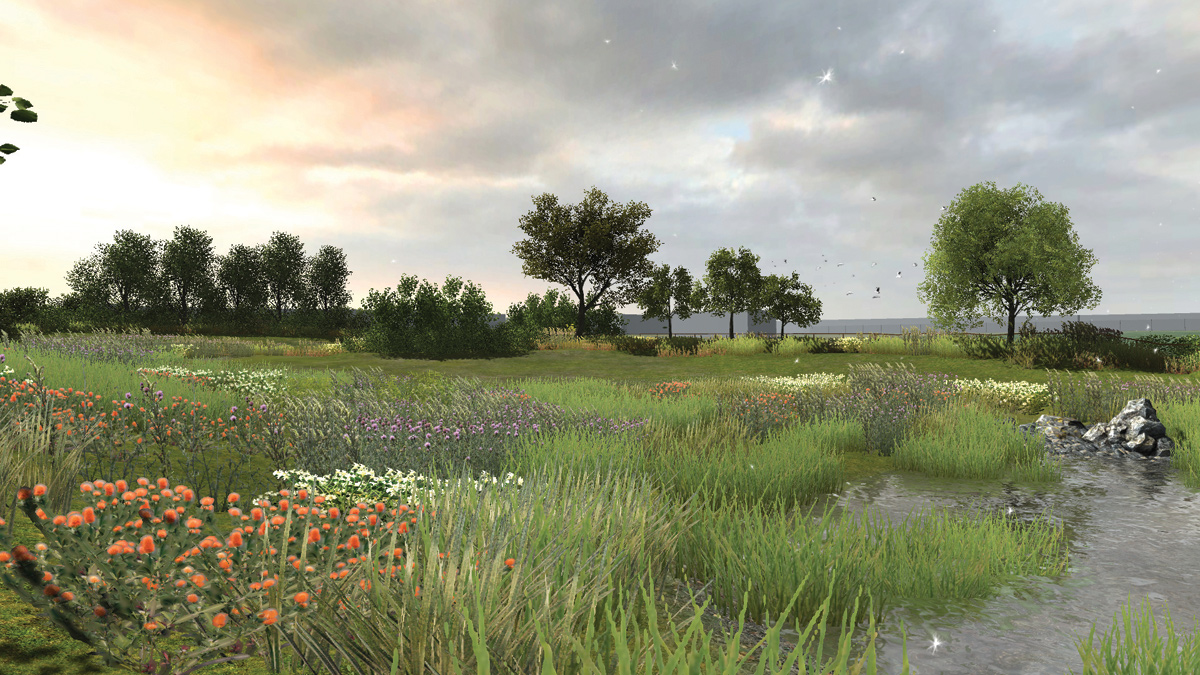
3D visualisation of the pond at St Josephs School - Courtesy of MWH
Fellgate estate in Jarrow, Tyne and Wear has a history of flooding and suffered extensive property flooding in 2012, affecting 175 properties. Flooding originated from sewers, highway drainage, runoff from land, small water courses and ditches during heavy rainfall. Northumbrian Water and the local authority South Tyneside Council share responsibility for surface water management and worked together to find a sustainable solution to flooding. The new solution, designed by MWH (now Stantec UK), comprised conventional sewer network enhancements, SuDS and exceedance pathways to manage surface water across the catchment. This included swales, bunds and detention basins that blend with the existing environment.
Background and project drivers
Flood risk management authorities are coming under increasing pressure to address current issues and manage surface water differently going forward. DEFRA’s surface water management planning (SWMP) guidance encourages different organisations to ‘work together and develop a shared understanding of the most suitable solutions to surface water flooding problems’.
Northumbrian Water (NW) and the local authority South Tyneside Council (STC) entered into a partnership agreement to work together to tackle flooding. The partnership allowed the organisations to share funding, jointly procure design and construction services and work together towards a common solution. All parties were keen to identify the most sustainable solution to flooding while meeting their business need.
Using a sustainable approach to surface water management, the team was able to provide the most suitable solution for NW, STC and residents whilst creating wider benefits for the community by:
- Developing a common understanding of the problem and working together towards a shared solution.
- Identifying sustainable drainage systems (SuDS) where feasible over conventional drainage.
- Identifying added value opportunities including biodiversity enhancement, amenity and education.
- Engaging with the community throughout the project to win support.
The solution
The solution comprised conventional sewer network enhancements and SuDS measures. Works were phased to meet regulatory deadlines and suit various funding sources.
- Phase 1: During the first phase NW funded upgrades to the surface water sewer network and removal of a drainage ditch and watercourse from the surface water sewer which significantly reduced the risk of sewer flooding. Upgrades to the surface water network to increase sewer capacity and repair collapses comprised construction of 2,223m of concrete pipe, with sizes ranging from 300-800mm diameter. The drainage ditch and watercourse were intercepted by detention basins, also serving as surface water management measures described below.
- Phase 2; The second phase, funded by STC, the Environment Agency Flood Defence Grant in Aid (FDGiA), local levy and private contributions delivered surface water management measures to protect against flooding up to the 1:100 year return period.
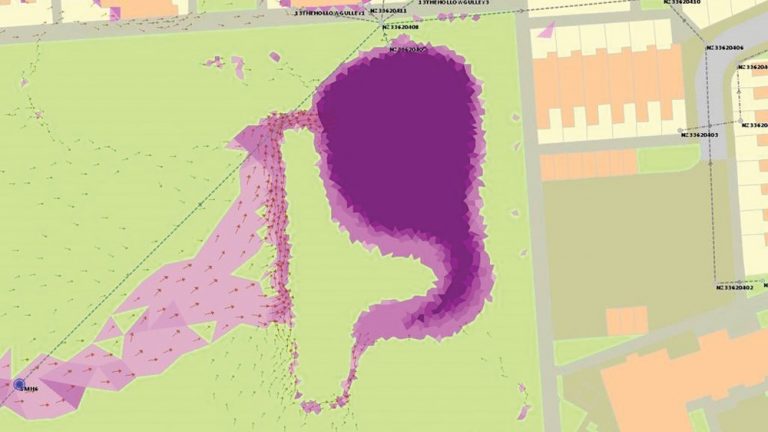
The hydraulic model identifies overland flow routes – Courtesy of MWH
‘Soft’ engineering
The project team selected ‘soft’ engineering where possible over hard engineered SuDS and conventional drainage for surface water management.
- Detention basins: A detention basin is a normally dry depression, where during storm conditions, excess surface water is stored and then slowly drains at a controlled rate to a receiving watercourse or surface water sewer. Basins were of irregular, curving shape to give a natural appearance and had gently sloping sides to provide access for grass cutting and maintenance.
- Swales: A swale is a normally dry vegetated channel used to convey surface water. Swales were formed into the existing ground with gently sloping sides and shallow fall to slow and capture runoff and encourage infiltration. Swales were finished with topsoil and seeded with amenity grass seed mix. Swales close to housing were under-drained to assist infiltration.
- Bunds: A bund is an impermeable mound used to contain or divert surface water. Bunds were formed with shallow graded sides to permit grass cutting, finished with topsoil and seeded with amenity grass seed mix.
Measures were installed in the following locations:
- Detention basins in fields south of Durham Drive to intercept a watercourse and field drainage.
- New swale and pond in St Joseph’s RC Primary School playing field.
- New swale on Rochester Square and detention basin in Fellgate Primary School to intercept and store surface water runoff from the community centre playing fields.
- New swale and detention basin in Hedworthfield Community Centre to intercept and store surface water runoff from playing fields.
- Modifications to existing highway drainage to capture surface water and direct it towards Calfclose Burn.
- New swale and filter drain to transfer surface water runoff to a new detention basin in grassland north of Fellgate Primary School.
- New bund along the verge at the western end of Durham Drive to contain surface water runoff in the field.
- New swale and pond in Fellgate Primary School field to intercept and store surface water runoff from the playground.
SuDS use less concrete, less raw materials and they have a lower environmental impact and lower cost than conventional drainage.
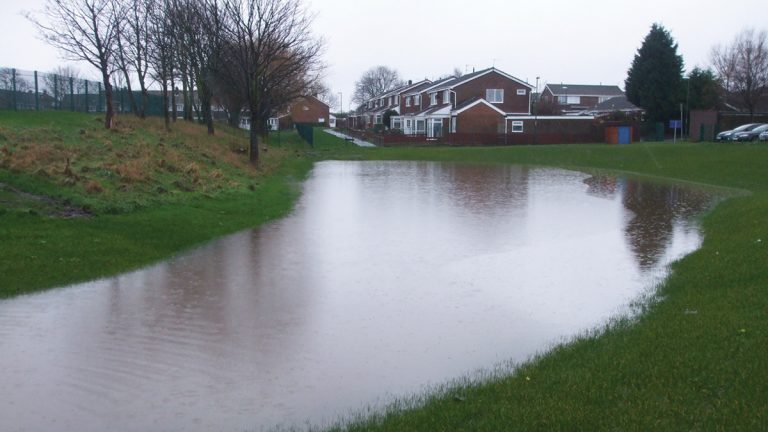
Detention basin during heavy rainfall of winter 2015 – Courtesy of MWH
Design approach
The design approach applied latest best practice for surface water management schemes and required a wider design team having different skills. A landscape architect developed a landscape plan, planting scheme and habitat design to create a natural look and feel for the measures, and an ecologist provided advice on planting and liaison with schools.
The study used an integrated model which included a representation of the sewerage system, surface water drainage system, watercourses and rural runoff from fields and green space. The model quantified flood risk at each property, an assessment necessary to obtain FDGiA funding.
The network model was verified against a short term flow survey consisting of flow monitors across the sewer network and gauges in the watercourse. The ground model was checked to ensure interactions with watercourses and overland flow paths through the catchment correlated with eyewitness statements. A flood risk assessment was undertaken using the MWH flood risk tool.
Civil 3D was used to develop the solution and grading tools and clash detection used to optimise the design. Visualisations were created using the 3D model and landscape plan and were used for customer events and interactive educational tools.
Construction
ESH Construction, Northumbrian Water’s framework supplier, was appointed for this project under an NEC Option A contract.
Phasing of the works ensured that below ground construction was completed before above ground earthworks to minimise disruption to the community. In Phase 1, upgrades to the surface water sewer network took place between September 2014 and May 2015 and was immediately followed by construction of the Phase 2 surface water management measures which completed in December 2015.
The contractor employed a machine control system to form the landscape features, with input from the 3D model. The system was Trimble 3D GPS and the subcontractor was GR Potter Plant Hire Ltd.
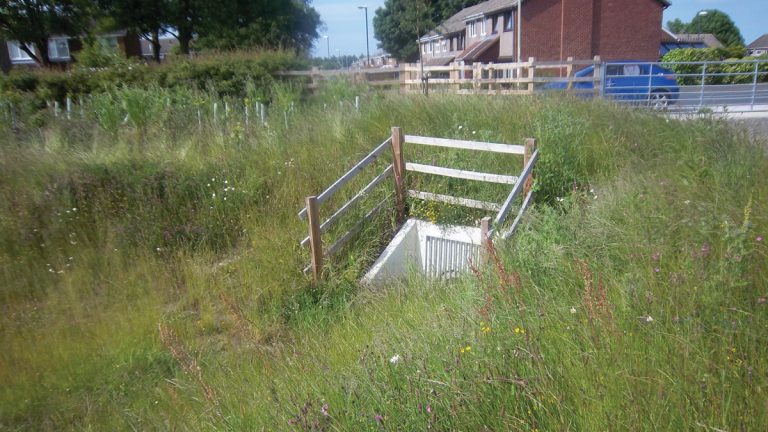
Wildflower meadows make an attractive feature and enhance biodiversity – Courtesy of MWH
Basins and swales were excavated in mainly clay soils and no lining was required. Bunds were constructed from clay soils excavated from other locations around the site and compacted using sheep foot rollers. Using cut and fill assessments, spoil from excavations was reused to form flood landscaping bunds to minimise spoil taken off site.
Planting was seasonally dependent. Wild flower planting took place in November 2015. Marginal planting of ponds took place in May 2016. Planting was undertaken by Esh Construction, Deerness Fencing & Landscaping (Phase 1) and Whartons (Phase 2).
The works were located at multiple sites across the estate and required working in schools, a community centre and other sensitive areas. The contractor put in place measures to minimise disruption and keep residents informed:
- Programming of works to maintain access routes.
- Contractor’s Considerate Constructors initiatives including bin collections and reduced working hours to manage morning and evening traffic.
- Posting notices of upcoming works.
- Using matrix signs/portable changeable message signs.
- Shuttle bus service for residents during road closures to maintain access to public transport links.
- Individual measures for helping special care customers.
Construction was completed within programme and within the businesses budgets.
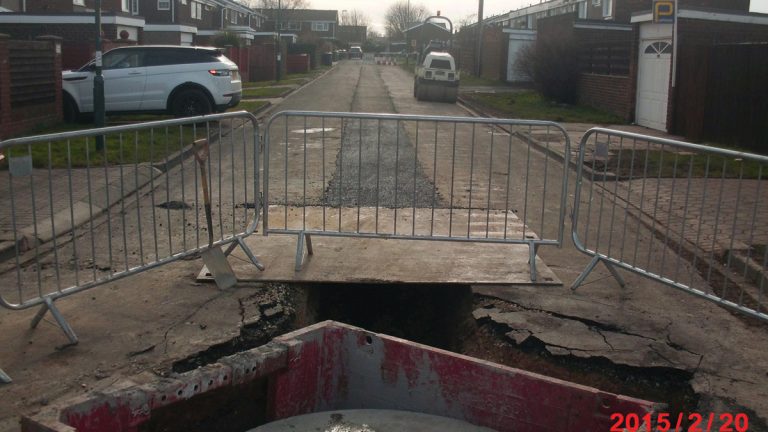
Pipework construction took place in narrow residential streets – Courtesy of MWH
Partnering encourages a common understanding of the problem and shared responsibility
Collaborative working began from informal discussions to share information and developed into an agreement for joint delivery of the project. The partnership generated a number of efficiencies:
- Organisations work towards a common, sustainable solution.
- Opened up other funding streams.
- Joint procurement of design and construction services, saving time and duplication of effort.
- Programme benefits and avoided redundant interim work by sequencing the delivery.
- Resolved land entry and planning constraints.
- Reached agreement on adoption and maintenance of SuDS.
The partnership delivered a more suitable and sustainable solution, having greater level of flood protection to properties, wider benefits to the community and lower overall cost than could be achieved by the individual organisations.
The SuDS approach creates added value opportunities
SuDS offer wider benefits than flood risk reduction as they can also improve water quality, provide new habitat, enhance biodiversity, create spaces for communities to come together, provide educational benefit and improve the health and wellbeing of people as they interact with nature.
SuDS provided the opportunity for biodiversity features including:
- Ponds within two primary schools.
- Wildflower meadows within detention basins.
- Extending an existing wooded area with native trees and shrubs.
- Insect hotels at schools.
Further benefits were achieved through education:
- Providing an outdoor classroom space.
- Education sessions supported by Wetland & Wildlife Trust.
- Tree planting event.
- Local school workshops on construction process and the water cycle.
The concept met the flood risk improvement objectives whilst providing added value to the community.
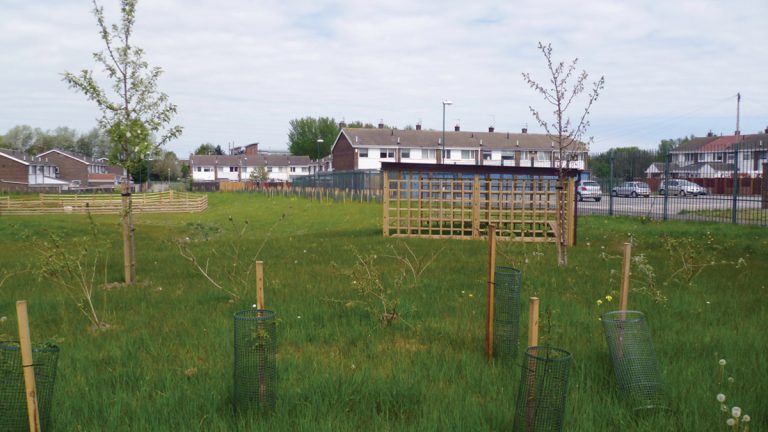
Further benefits were achieved through education sessions and outdoor classroom space – Courtesy of MWH
Engaging with the community wins local support
The project team recognised the importance of gaining public support and the value of engaging early. The design considered the finish of above ground measures and how they fit into the landscape and impact on the community. Schools and the local community centre were engaged during the design to ensure and health and safety concerns were addressed and agreements reached.
The partnership held a joint customer event to inform the local community and jointly engaged with schools and community groups. Drop in sessions providing a more informal setting for residents to engage with NW, STC, the consultants and contractors were well attended and positively received.
Early community involvement drew support for the scheme and allowed residents to build good relationships with the contractor. Community engagement continued during construction with the contractor’s initiatives on site, NW/STC customer support teams and assistance from local councillors.
A customer liaison officer was appointed to manage customer needs and concerns and information board maintained to advertise upcoming works. Building on the SuDS biodiversity enhancements, further engagement was achieved through the education initiatives.
The project gained a positive response from the community.
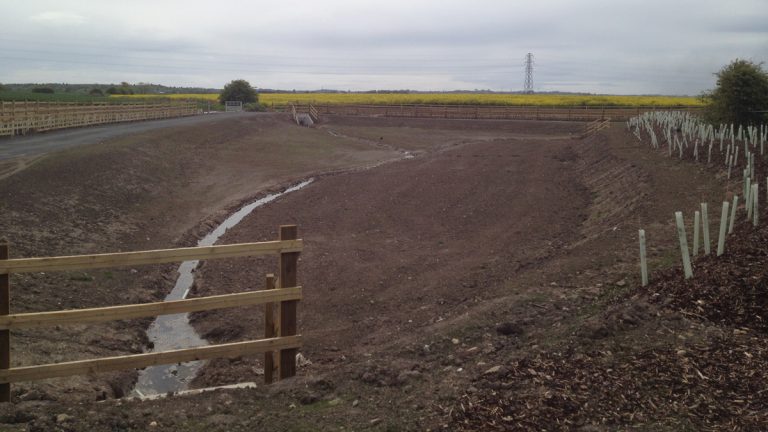
Detention basins are soft engineered structures formed from native soils – Courtesy of MWH
Summary
By working in partnership, the project team delivered a more suitable and sustainable solution, having greater level of flood protection to properties, wider benefits to the community and lower overall cost than could be achieved by the individual organisations.
Community engagement initiatives proved successful in managing the acceptance for the proposals and securing longer term benefits. The project has been successful at recent industry awards at local and national level.



